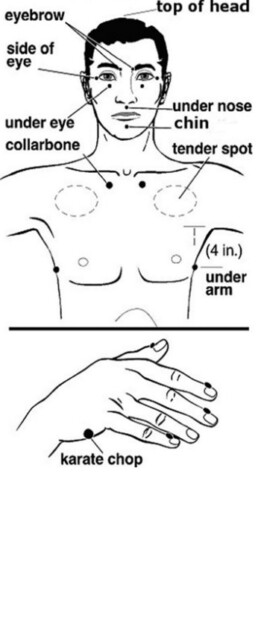Introduction to the meridians and the acupoints
A meridian researcher claimed that “if we do not understand the meridians, it is hard to understand TCM (traditional Chinese medicine).” In the world of energy psychology, we can add that we cannot really understand energy psychology tapping unless we understand the concept of the meridians. Interestingly, the meridians are very closely related to the nadis of Ayurveda, the traditional medicine of India. The ancients seem to have understood something about how energy flows through our bodies and affects our health and wellbeing. Here is an overview of what they knew, and an introduction to the meridians.
Introduction to the meridians.
Energy flows through our system along a pair of major vessels and a set of lesser meridians. The energy, or chi, moves throughout the body along these lines. Each line relates to a bodily organ and an emotion or set of emotions. We begin our coverage with the two major vessels, and then proceed to the twelve meridians following the order of tapping points from EFT, TFT, and TTT from top to bottom!
The governing vessel.
The tapping point for the governing vessel is the point on the upper lip under the nose. The vessel itself runs from there to the bottom of the coccyx. The governing vessel, along with the central vessel, store chi and “blood” for the twelve meridians.
We can trace lack of movement and pain to problems with the governing vessel. Additionally, there are several emotional issues related to the governing vessel. These include embarrassment and self-esteem issues. What’s more, they are related to the future and how we envision our future and our future self.
The central vessel.
The central vessel is sometimes called the conception vessel. Its tapping point is the spot under the bottom lip at the chin crease. The central vessel runs from the perineum to the bottom lip. Along with its partner the governing vessel, it stores chi and “blood” for the meridians.
If you experience issues related to sexuality and the organs of reproduction, you may be experiencing issues with your central vessel. (Menopause symptoms, anyone?) Imbalances in the central vessel also leave us feeling weak or depleted. Now, on the emotional side, problems like shame and inability to launch future projects may come down to a problem with the central vessel.
The bladder meridian.
The treatment point for the bladder meridian is located at the inside eyebrow corner by the bridge of the nose. Predictably, the bladder meridian relates to bladder functions. This is not only elimination, but possibly lower back pain and even problems sleeping.
The emotions associated with the bladder meridian include irritability. Additionally, the bladder meridian is an important point for trauma. Some schools of thought hold that the bladder meridian also relates to jealousy and suspicion.
The gall bladder meridian.
The gall bladder meridian’s treatment point is at the outside of the eye. Just as the gall bladder creates bile which we use to digest food, its meridian relates to digestion. Other issues related to the gall bladder meridian are headaches and jaw tension as well as pain in certain joints.
The emotions we associate with the gall bladder are visceral anger: rage, fury, and wrath. On the other hand, some schools of thought hold that the gall bladder relates to decision making and the ability to make sound judgments.
The stomach meridian.
The tapping point for the stomach meridian is under the eye. This meridian is related to digestion and imbalances lead to indigestion, reflux, belching, and nausea.
Fear and anxiety are the emotions we most commonly associate with the stomach meridian. Imbalances of the stomach meridian can also lead to greed or disgust.
The kidney meridian.
The kidney meridian tapping point is located just below the notches of the collar bones. This is the K27 point, which is renowned for alleviating anxiety! Kidney meridian issues include issues with urination, as well as night sweats, dry mouth, and memory problems.
Fear and anxiety are the main emotions we associate with the kidney meridian. To illustrate the point, people who are insecure or aloof may be experiencing problems with the kidney meridian.
The spleen meridian.
We use the point under the arms at the bra strap area to access the spleen meridian. As the spleen relates to our immune system and production of red and white blood cells, issues related to spleen meridian imbalances include tiredness, bleeding and bruising, a heavy menstrual flow, as well as poor digestion and a distended abdomen.
Worry much? If so, you may have an imbalance in your spleen meridian. Other issues related to the spleen meridian include overthinking and being obsessed with things.
The liver meridian.
The liver meridian tapping point used in TFT and TTT is on the bottom rib under the nipple, the LR 14 point. Surprisingly, this liver meridian point is not activated in EFT. Apparently, many larger-breasted women felt uncomfortable accessing the point! However, some classically trained, long-term EFT’ers out there still use it. Interestingly, there is another liver meridian point, the LR 13, just below the spleen point we use in tapping. We are probably getting a two-fer when we tap under our arms!
Headaches, dizziness, and eye issues may signify issues with the liver meridian. The main emotion we associate with the liver meridian is anger. Irritability, resentment, bitterness, and flying off the handle can also relate to liver meridian imbalances.
The lung meridian.
The lung meridian tapping point we use is at the thumb nail bed on the side away from the index finger. Issues related to the lung meridian, not surprisingly, include all the respiratory issues like coughing, congestion, breathing issues, sore throat, and loss of voice.
Sadness and grief are the emotions associated with the lung meridian. Interestingly, EFT does not activate the lung meridian directly. Neither does it directly use the large intestine, pericardium, or heart meridian. However, we may use these points we tap on the top of the head, for instance, and also if we use the fingers of one hand to stimulate the side of the hand during the setup phase.
The large intestine meridian.
The large intestine treatment point used in energy psychology tapping protocols is on the index fingernail bed on the thumb side of the hand. Not surprisingly, problems with the large intestine meridian include predictable culprits like constipation, diarrhea, and abdominal pain. Like the other finger points, these are activated in EFT during the setup phase and tapping the top of the head.
The emotions we associate with the large intestine include guilt. Other schools of thought, however, hold that the large intestine meridian relates to sadness and grief, and that it works in tandem with the lung meridian.
The pericardium meridian.
The tapping point for the pericardium is on the fingernail bed of the middle finger on the side close to the index finger. Symptoms of an imbalance here can range from restlessness to fluttery chest to chest pain.
The emotions we associate with the pericardium include life flow and issues related to sexuality. Additionally, others hold that the pericardium meridian is responsible for extreme emotions, including bipolar kinds of mood swings.
The heart meridian.
The heart meridian tapping point is on the fingernail bed of the little or pinky finger on the side closest to the ring finger. Again, as with the other finger points, these are activated in EFT during the setup phase and tapping the top of the head. Issues related to an imbalance in the heart meridian include high blood pressure and heart palpitations. Heart meridian emotions include hatred and specific anger as well as anxiety and insomnia.
The small intestine meridian.
The small intestine tapping point is familiar to everyone who does tapping: It is the side of the hand, where we do our setup statements and begin our tapping series. Issues related to the small intestine include pain in the cervical spine, shoulders, and shoulder blades as well as tongue sores.
Emotions that we associate with an imbalance in the small intestine include vulnerability and sadness. More importantly, the small intestine meridian helps us sort out our emotions. Just as the small intestines themselves separate the pure and useful from the impure that we eliminate, the small intestine meridian separates the pure emotions from the impure ones that we want to eliminate.
The thyroid or triple warmer meridian.
The tapping point for the triple warmer meridian is located on the back of the hand between the bones leading to the pinky and ring fingers. Indeed, this spot will be familiar to anyone who does the 9-gamut. Issues chiefly related to the triple warmer meridian include pain, swelling, problems with urination, problems with hearing and tinnitus (ringing in the ears). Emotions that we associate with a blocked triple warmer include depression, overwhelm, stress, and sadness.
Now, what will you do with your introduction to the meridians?
Now that you have this basic understanding of the meridians, what will you do with your knowledge? All things considered, if you are a licensed clinician and would like to put this energy to use in your practice, consider ACEP’s EFT training, specifically designed for licensed mental health professionals. And don't forget to check out our foundations of energy psychology blog series!
Author bio:
Sarah Murphy, LPC, ACP-EFT, is an ACEP Board member and chair of its communications committee. She has a private practice where she specializes in helping people with serious or chronic illness.
Research on energy psychology: study validates the effectiveness HMR
Brent Baum and his colleagues researched the feasibility of Holographic Memory Resolution, or HMR, to alleviate depression, anxiety, pain and PTSD. They found patients’ depression, anxiety, symptom burden, and PTSD all decreased after just four 90-minute HMR sessions. The online journal Psychiatric Research and Clinical Practice published the study, The Use of Holographic Memory Resolution to Improve the physical and biopsychosocial symptoms of chronic pain: A feasibility, mixed methods study. It is exciting to see more research on energy psychology!
The theory
HMR is a bodymind therapeutic approach that incorporates verbal and somatic components to access and heal traumatic memories. Brent Baum, a psychotherapist and former Catholic priest, founded the method. He and his colleagues decided to investigate HMR as a protocol to address the symptoms of depression, anxiety, PTSD, and pain.
The study setup
The mixed-methods study included 60 adults. The study excluded individuals taking mood altering substances. Eighty-five of the subjects were female, and 87% were Caucasian. Fifty-two percent reported high risk for toxic stress. Researchers used the Generalized Anxiety Disorder - 7, the Patient Health Questionnaire, the Somatic Symptom Scale, the PTSD Checklist for DSM-5, and the Subjective Vitality Scale to assess symptoms. Participants received four 90-minute HMR sessions.
Study results
Four symptoms decreased significantly: depression (p = 0.05), anxiety (p = 0.03), symptom burden (p < 0.01) and PTSD symptoms (p = 0.01); vitality improved as well. The authors concluded, “HMR may be a feasible intervention to address chronic pain and accompanying biopsychosocial symptoms; a randomized controlled trial is the next step to measure efficacy. Unlike other mind‐based therapies, HMR® participants use their own internal language for identification and resolution of the pain. The trauma imprinting can then be gently addressed, and the memory‐based components of pain resolved or reduced, which empowers participants to improve their well‐being.”
Growing research on energy psychology
This study adds to the growing body of research showing that integrative approaches to mental health can be quite effective. And we are excited to see non-tapping therapies getting some research attention!
Do you love research? You can stay up to date with the research on energy psychology here, and ask research committee chair John Freedom at to add you to his research mailing list. Learn about the science of energy healing (and earn continuing education credits)! Want to be involved in energy psychology research? You can participate in ACEP’s collaboration with Peta Stapleton. Learn more here.
Author bios:
John Freedom, CEHP, serves as chairman of ACEP’s research committee. The author of Heal Yourself with Emotional Freedom Technique, he presents seminars and events throughout the US and in Europe.
Sarah Murphy, LPC, ACP-EFT, is an ACEP board member and communications committee chair. She is a counselor in private practice and specializes in working with people who have serious illnesses.
Research Update: Review Shows EFT is an Effective Treamtent for PTSD
Frontiers In Psychology published a systematic review and meta-analysis demonstrating that EFT is an effective treatment for PTSD. The study, Emotional freedom techniques for treating post traumatic stress disorder: an updated systematic review and meta-analysis, showed that Clinical EFT produces a greater symptom reduction than no-treatment or “treatment as usual” studies. Furthermore, EFT produces symptom reduction similar to that of other evidence-based approaches. Finally, studies using EFT to treat PTSD have large treatment effects. We tip our hats to Peta Stapleton, Kevin Kip, Dawson Church, and the whole team for their efforts in showing that EFT is an effective treatment for PTSD.
The theory
The researchers wanted to update the literature on using EFT to treat PTSD. They noted that while cognitive behavioral therapy (CBT) is a common and empirically validated approach to treating PTSD, it does not work in as many as 50% of cases. Moreover, a review of 36 studies found two-thirds of military personnel still met diagnostic criteria for PTSD after cognitive reprocessing or prolonged exposure therapy. Meanwhile, although medications such as SSRIs can be effective at reducing symptoms, relapse is common at cessation of treatment.
Against this backdrop of treatment options, researchers note that as many as 30% of combat veterans will experience PTSD, and nearly 7% of Americans will experience PTSD in their lifetimes. Indeed, PTSD is an accelerating mental health condition worldwide. Finding effective strategies to treat it is important.
The researchers also dug a little deeper into the research on acupuncture, since acupoint stimulation is a key component in EFT. Their investigation covered an 11-year period and found 13,000 studies and 2,500 reviews. Of 122 medical and mental-health conditions studied, acupuncture was effective in treating 117. And, importantly, the previous meta-analysis on EFT for PTSD found a large treatment effect size.
The study setup
For the current review and meta-analysis, researchers combed through ten databases to find randomized controlled trials and quantitative reviews on EFT for PTSD. Six studies met inclusion criteria.
Study results: EFT is an effective treatment for PTSD
Clinical EFT, when compared to no-treatment, waitlist, or treatment-as-usual controls, produced significant and large effect sizes ranging from 1.38 to 2.51. When compared to active controls such as CBT and EMDR, effect sizes ranged from -0.15 to 0.79. These treatment results are similar to other evidence-based therapies.
Notable
Therapies such as EMDR and EFT, incorporating a somatic component, have not been widely accepted in clinical settings. Talk therapies have been around for much longer and therefore have many more studies to back them up. Nonetheless, EFT and EMDR have been supported by more than 100 clinical studies each, and the research base is growing. The studies show that these are effective treatments for PTSD, anxiety and depression, with results maintained at follow-up.
Why this study matters
This study adds to the growing body of evidence supporting EFT for treating PTSD. Importantly, Frontiers is a Q1 journal, the highest rank of professional journals as measured by criterion impact factor. Criterion impact factor measures how often articles published in a journal are cited by other authors. Publication in a top-notch journal like this is a win for EFT research!
Action plan
Want to learn more about EFT while earning continuing education credits? Sign up for certification in EFT. Do you like research? Stay up to date with the research on energy psychology here. Want to be involved in energy psychology research? You can participate in ACEP’s collaboration with Peta Stapleton. Learn more here.
Helping a patient recover from mental illness without drugs
Alice Lee, M.D., is a holistic psychiatrist who uses an innovative approach, using energy psychology to help patients recover from mental illness without drugs. At the 25th ACEP conference, she shared a detailed case report of a patient who weaned from six different psychotropic medications as she healed from her diagnosis of bipolar disorder. It’s a fascinating story and one we thought you should know!
Background
The patient was 60 years old when she began treatment with Alice. Before her mental health problems arose, she had had a successful albeit stressful career. In 2009, she was diagnosed with breast cancer, which she successfully treated with conventional and holistic methods. In 2017, her daughter became ill. The combined stress of her job and her daughter’s illness became too much.
She began intensive therapy with a “normal” clinician, whom she saw for six months with little relief. Finally, she decided to try an antidepressant. Weeks later, she attempted suicide by overdosing on the new medications.
For almost two years, she cycled in and out of inpatient hospitalizations and residential treatment programs. She ended up taking six medications: two antidepressants, a beta blocker for anxiety, an antipsychotic, an anticonvulsant, and a benzodiazepine.
A holistic approach: recover from mental illness without drugs
After nearly three years of standard psychiatric treatment, the patient sought a holistic approach, and found Alice Lee. Alice uses energy psychology and CBET, criteria-based energy testing, to guide her treatment approach. CBET uses applied kinesiology or muscle testing to gather true-false statements. Alice uses the thumb-and-index finger method of testing. Because muscle testing is sensitive to energy, it was important for Alice to remain neutral during her work.
Diagnosis
The patient had been diagnosed with a number of disorders and had landed with a diagnosis of bipolar disorder with psychotic features. However, she had never experienced a manic episode. Alice switched the diagnosis to panic disorder. This gentler diagnosis itself may have helped initiate the healing.
Prognosis
The patient and Alice worked together for a year. At the end of treatment, the patient was doing well. Two years later, she continues to do well. Her prognosis, Alice reports, is excellent.
Treatment
Alice used the Infinite Intention Technique, a type of energy psychology. CBET guided the work. The patient also used various supplements, psychotherapy, and tapered off her medications.
Recovery pattern
At the outset of the holistic psychiatric treatment, the patient and doctor worked together to support and begin healing without changing medications. In the next phase they began gradually reducing medications, guided by CBET. The patient regularly experienced a slight uptick of medication side effects about two days before a follow-up session. After the medications were decreased, the symptoms would subside.
Outcomes
After a year of collaboration and gradual withdrawal from the medications along with adherence to the supplement and self-care regimen, the patient had successfully stopped all medication. She reported better energy and maintained her positive energy and wellbeing for more than six months of follow-up.
A new direction?
Patients and clients are increasingly seeking alternatives to standard pharmaceutical interventions for their mental health issues. They want to recover from mental illness without drugs. There are good reasons for this: the cost, side effects, problems with withdrawal, and of course, the inability of pills to resolve the underlying causes of these problems. Energy psychology is a growing field of cutting-edge interventions that help people heal. As more people learn about the problems of standardized care and the potential energy psychology, more people will receive the kind of help that really helps.
Do you want to be a part of this change? Share this article with your friends and colleagues. By joining ACEP, you’ll get stories like this delivered to your inbox every week. And your funds help our organization grow, supporting research, training, and spreading the word about EP.
Types of trauma, explained
Acute, chronic, or complex. Not all trauma is the same, but the impacts of trauma are widespread and well documented. There are different types of trauma, but they all can leave us scarred, with lasting effects on our physical, emotional, mental, social, or spiritual functioning. Some traumas, like war, car crashes, and assaults, are called acute or “Big-T” traumas. Others, like being belittled or embarrassed, are called chronic, or “little-t” traumata. Complex traumas refer to children’s exposure to multiple, ongoing traumatic events which have long-term, wide-ranging effects. The differences in these types of traumas are clear but the results of each type can be devastating. Our work as clinicians is to help our clients overcome the effects of their traumatic experiences. Energy Psychology is particularly helpful in addressing trauma.
Acute Trauma
The most well-known and well-documented aftermath of trauma is post-traumatic stress disorder, or PTSD. Soldiers returning from the first world war were “shell shocked”. Its history is much longer, with references in literature as far back as 2,000 years ago. You can read a fascinating summary of it here.
It was in the 1980s that the American Psychological Association included PTSD in their glossary of mental disorders, the Diagnostic and Statistical Manual (DSM). Even then, the mental health establishment considered it incurable. Thanks to advances in treatment approaches, and the growing acceptance of body- and energy-based practices like EMDR and EFT, we now know that PTSD is something that people can indeed heal from.
We often associate PTSD with war trauma, and rightly so. Today, we know that other traumatic experiences can also lead to PTSD. Things like vehicle accidents, assault, and rape leave their mark, and the mark is often PTSD. We call this set of traumatic experiences acute or “big T” traumas.
Effects of acute trauma
The classic symptoms of PTSD include intrusive thoughts, nightmares, hypervigilance, and emotional or physical reactions to trauma reminders. These problems lead to behavioral changes as the sufferer tries to avoid the trauma. They either avoid places and things that remind them of the trauma or try to avoid their own thoughts and feelings. They also cause changes in mood and reactivity as the trauma sufferer grapples with their unresolved trauma.
Until now, people with PTSD suffered, and dealt with it as best they could. They often used drugs, prescribed or not, to try to mask or manage their symptoms. They sweated their way through talk therapy sessions until they stopped going. Sometimes they got a bit of relief for their efforts.
The prognosis changed with the advent of somatic and energy-based techniques like EMDR and EFT. EFT, along with Thought Field Therapy (TFT) and the Trauma Tapping Technique (TTT), are acupressure-assisted exposure therapy and they help people heal trauma. Now, PTSD sufferers can find quality help to overcome their trauma symptoms as they remove the emotional valence from their trauma memories. You can read about the research on EFT for PTSD here.
Chronic or little-t trauma
Little-t traumata are more personal and much more common. Anyone can experience these. Think of the loss of a job, financial stressors, relationship breakups, and even problems with family, friends, and friend groups. These are traumatic, but not in the same ways as big T trauma can be. However, they leave us less resilient, and we need to heal them.
Often, people who experience these types of traumas think they “shouldn’t” feel as upset as they do. However, every traumatic experience leaves us with less resilience to deal with the next one. The effects of trauma are cumulative and get more difficult as each succeeding trauma is left unhealed.
Complex, childhood, ongoing trauma
The ACEs or adverse childhood experiences study found that people who experienced adversity during childhood were more likely to develop problems in adulthood. These problems include obesity, depression, heart disease, COPD, and early death. The triggering childhood adversity includes abuse, neglect, and household challenges. The more ACES, the worse the problems.
People who are members of the LGBT community and people who identify as BIPOC are at an increased risk of trauma. This is because they experience many microaggressions which cause trauma responses. Persistent trauma takes its toll on health and wellbeing. Two examples are the increased rate of Black women dying in childbirth and the increased risk of suicide among LGBTQ teens.
The problem, however, does not exist only among members of diverse communities. Even children of privilege can endure traumas that leave their marks. Having parents who are poorly emotionally regulated; being bullied in school; experiencing academic problems; cyberbullying; and even social media-induced social comparisons can leave a scar no matter the cultural background of the family or status of the individual.
The effects of trauma.
No matter the type of trauma, the effects can be pretty much the same. They include flashbacks, nightmares, problems sleeping, hypervigilance, irritability, physical symptoms, intrusive thoughts, and distress. For adults who experienced complex trauma, the fallout can include relationship problems, insecurity, attachment fears, and emotional labiality. Clinicians see the fallout of both types of traumas in our practices every day.
Helping with both types of trauma
When our clients come to us with the aftermath of trauma, energy psychology methods are particularly effective. Conventional approaches have been lackluster in their results. EFT, on the other hand, is very effective at treating trauma. Thought Field Therapy or TFT helped many people overcome the aftermath of trauma, such as after the genocide in Rwanda. Other energy psychology approaches such as Advanced Integrative Therapy or AIT, and holographic memory resolution or HMR, also show promise. In every case, clinicians have pushed the envelope, looking for more effective treatments to help our clients overcome their traumatic experiences. That is how we make progress, and this is where energy psychology shines!
Want to deepen your skills? Sign up for ACEP's trauma-informed EFT training designed especially for licensed mental health providers.
Author bio:
Sarah Murphy, LPC, NCC, is a licensed and nationally certified professional counselor. She specializes in energy psychology, including EFT, as well as mindfulness and meditation. Sarah works with people who have cancer or other serious medical diagnoses, individuals seeking to find peace within themselves, and couples who want to resolve conflict and live in harmony. Sarah is an ACEP Board member and chair of its communications committee; she has a private practice and serves as a counseling provider for Unite for HER.
Energy psychology online: Five reasons this is a perfect fit!
The pandemic is hopefully fading into our rearview windows, though the covid-19 virus with its myriad variants is here to stay. We are learning to live with these new risks, adjusting to the new normal, and learning to love some of the changes that the pandemic brought about. One of those changes is the explosion of teletherapy! Back in 2020, people wondered if energy psychology was going to be as effective when delivered online. Today, the resounding answer is YES! Here are five reasons why doing energy psychology (EP) online is powerful and effective as it is in person.
Tapping Tools Work Well
Energy Psychology’s tapping tools, such as EFT and TFT, work like a charm over Zoom (or other online platforms). People can assess their distress before and after each round of tapping. In some ways, the screen makes things easier. For example, it is really easy to show people the finger points on camera. Even the 9-gamut eye roll is doable online! The imaginary clock in front of the client’s face is a great way to “walk” their eyes around the circle. Tracing outside their glasses frame is another trick that some people can use. (for information about the finger points and 9-gamut, go here – link to listicle blog “Simple Tools that Get Great Results”).
We Can Do Muscle Testing by Proxy
Some energy psychology tools, like TFT, can incorporate muscle testing, also known as applied kinesiology. The principle of muscle testing is that our bodies are strong when we are expressing a truth, and weak when we are expressing a lie. The body doesn’t lie! In the old days, we often used the arm test to see what acupoints were at play. Fortunately, we don’t need the client’s arm to do muscle testing. There are many other approaches, such as the postural sway and the finger lock, that can differentiate the true from the false. (For more information on applied kinesiology, read this).
Consciousness is nonlocal.
We can have telepathic connections with others – it happens all the time! How often do you and your bff say the same thing at the same time? You don’t have to be in the same room to connect with their vibe, their energy, their thoughts and feelings. When we are deeply and empathically connecting with our clients, we still “feel them” even when they are on Zoom.
Everything is energy, and teletherapy may save yours
We can connect when we are on Zoom, but maybe we have more of a choice about it than when we are physically together. At the beginning of the pandemic, people complained of Zoom fatigue. Dayslong Zoom meetings can still be a bore. But Zoom therapy is a different animal altogether. Some people, including yours truly, actually find ourselves less tired at the end of a Zoom day than an in-office day.
Clients want results, and energy psychology delivers.
Whether you are using approaches that rely on language (like AIT and EFT), tapping (like EFT and TFT), chakras (like AIT and CEP), energy psychology delivers reliable outcomes. Our clients are happy, and our clinicians are committed to continuing to use and spread the word about these fabulous techniques.
Teletherapy is perfect for energy psychology.
No matter how you look at it, the cutting-edge family of techniques we call energy psychology are a perfect fit for today’s move toward online therapy. What started out as a response to a crisis has become mainstream. In doing so, it has given us a new way to make it easier than ever for people to access therapy and get the help they need to live lives they are excited about.
What are your favorite reasons to use energy psychology in your teletherapy practice? We would love to hear from you, so leave a comment below. If you would like to learn more about these exciting techniques, check out ACEP's training calendar.
Author: Sarah Murphy, LPC, NCC, is a licensed and nationally certified professional counselor. She specializes in energy psychology, including EFT, as well as mindfulness and meditation. Sarah works with individuals seeking to find peace within themselves, people who have serious medical diagnoses, and couples who want to resolve conflict and live in harmony. Sarah is an ACEP Board member and chair of its communications committee; she has a private practice and serves as staff therapist with Unite for HER.
Upset by memories? Try this.
Learn an easy tool you can use to help leave the past in the past.
One of the fastest and most effective ways to heal old memories is to tap lightly on a series of points on your body. One technique that can really help is Simple EFT (emotional freedom techniques)*. This simple body-based technique helps your body to relax and allows you to feel calm and balanced. It also is great for reducing stress quickly. You can also download written instructions in English, Spanish, and Portuguese.
How it Works
You can follow along with the video and do the EFT basic recipe: Tap on the side of your hand. Then tap the top of your head, inside eyebrows, corner of the eyes, under the eyes, under the nose, under the mouth, under the collarbones, and under the arms.
Why It Works
Being upset causes a disruption in the flow of energy through your meridians. Easy TFT helps your energy flow again by clearing blocks along your meridians. When you do this, you reduce stress quickly and easily. This allows you to reduce or even eliminate the troubling feelings that often accompany old memories.
If you haven’t given Simple EFT a try yet, do it now. Take notice of how your body feels both before and after you use the technique. This technique is just one of many you can use to resolve the feelings from memories and leave the past in the past.
More Techniques to Help Heal Old Memories
If you found Simple EFT helpful, here are a few more tools that you can use to calm anxious feelings: Easy Thought Field Therapy and the Trauma Tapping Technique. If you want to learn more about using techniques like this to improve your wellbeing, contact me.
Video Resources Provided by the ACEP Humanitarian Committee
The mission of the ACEP Humanitarian Committee is to develop and implement humanitarian projects that alleviate emotional distress caused by catastrophic natural and man-made events around the globe. We do this by encouraging and assisting ACEP members in developing humanitarian projects that utilize recognized energy psychology and other modalities that meet ACEP’s standards and guidelines. Learn more here.
Simple tools to boost your therapy results
Are you a therapist who is always looking for tools that get great results? If you are already using energy psychology tools like EFT, TFT, AIT, or CEP, you know how powerful these approaches can be. And as great as they are, sometimes a little tweak can lead to big improvements, even in an already-fabulous therapeutic toolkit! Here are four often overlooked yet simple tools to boost your therapy results.
Tapping the finger points
The most popular form of energy psychology is EFT tapping. EFT stands for the emotional freedom techniques. Plural. Yet we often think of it only as tapping the side of hand with the setup statement, then tapping the head and torso points while stating the problem. That is certainly the basic recipe for EFT. But there’s more!
Tapping the points at the base of the fingernail on the thumb, index finger, middle finger, and pinky finger allows us to access important meridians where energy can also be stuck. Try adding these points in your next EFT practice and see how it feels. You may be surprised at how powerful it is!
The 9-gamut
Another underutilized technique in EFT is what’s called the 9-Gamut. This term was coined by Roger Callahan, father of energy psychology tapping techniques and creator of Thought Field Therapy (TFT).
To do this, tap the back of your hand, between the bones leading up to the pinky and ring fingers. This is a treatment point for the very important Triple Warmer or thyroid meridian. This meridian is associated with a host of emotions. While steadily tapping this point, do the following nine things:
- Close your eyes
- Open your eyes
- Look sharply down to the left
- Look sharply down to the right
- Roll your eyes slowly in a big clockwise circle
- Roll your eyes slowly in a big counterclockwise circle
- Hum a little tune
- Count to five
- Hum a little tune
You will be amazed at how the distress level drops after doing this simple exercise. In fact, in online tapping groups, my group-members found that adding the finger points and 9-gamut reduced their SUDs (units of distress, on a 0-10 scale) by at least a point or two, and often more. Adding these techniques to a round of tapping, at least with these groups, seems more efficient than adding a new round of tapping.
The Brief Energy Correction
This is a simple tool that is taught in ACEP's comprehensive energy psychology training. It was designed to rebalance an energy field that had become scrambled, where the nerves are not sending the correct signals. A "tell" of this scrambling is homolateral walking (same arm and leg move forward together, rather than the opposite arm as normal). Confusion and clumsiness are also "tells".
Interestingly, Robin Bilazarian found that this simple exercise reduced workshop participants SUDs dramatically in just 90 seconds of practice. You can read more about Robin’s study here. Her article even has an image showing the hand placement!
To do this simple exercise, place one hand below your naval. Then place your other hand on the following areas, holding each for just one breath:
- Both sides of the collar bone, using thumb and index finger on either side
- Under the nose, using index and middle finger
- Under the mouth, using index and middle finger
- At the tailbone, with the back of the hand on your body and thumb facing upwards
The next time you need a quick fix for your energy or mood, give the brief energy correction a try. I recently guided a stressed-out client who was having therapy from his car in this subtle exercise. He dropped from a ten to a four after three rounds, and to a two after an additional three rounds. It was easier for him to do than a full tapping protocol because of logistics, and got him a dramatic reduction in just a couple of minutes.
Collar bone breathing
This is another simple tool that is part of the comprehensive energy psychology training but can be a fantastic standalone technique. It also was meant to help restore balance in a scrambled energy system and offered help for clumsiness and confusion. However, clinicians like Mandi Freger are using it to address more basic issues in therapy.
To do this technique, cross your hands over your chest with your fingers resting just below your collar bones. You’ll do two sets: for the first, put your fingertips under your collar bones. For the second set, place your middle knuckle just under your collar bones. For each set, breathe as follows:
- Inhale and exhale completely
- Inhale halfway and hold
- Inhale the rest of the way and hold
- Breathe halfway out and hold
- Breathe the rest of the way out and hold
- Inhale and exhale completely
Give this simple technique a try and see how easy it is to come back into balance!
Simple tools to boost your therapy results
These four simple tools will help you get great results, quickly and easily. Even better, they are free and have no side effects! Give them a try and see how you and your clients feel even better, even faster!
What are your favorite tools to use energy psychology in your teletherapy practice? We would love to hear from you, so leave a comment below. If you would like to learn more about these exciting techniques, check out our training calendar.
Muscle Testing 101: Four Tools to Tune into Your Body’s Wisdom
We know that our body holds a storehouse of wisdom. Wouldn’t it be great to be able to tap into that? Well, it turns out, we can! The field of applied kinesiology, or as it’s more commonly called, muscle testing, gives us access to our bodies’ innate wisdom. Some of these tools are meant to be used on yourself, and others are meant to be used with another person. Each of them can be mastered with just a little practice. This “muscle testing 101” introduces four techniques that will help you understand your body’s messages.
Some people use these technique to find out whether a certain food or supplement is “good” or “bad” for their bodies. Others ask their body questions, especially when they are having trouble deciding, like “is taking this job for my best and highest good?” At ACEP, we use these in our comprehensive energy psychology program. It allows us to ascertain which problems need to be addressed first, whether we have scrambled energy, or which chakras or meridians to stimulate or clear. We don’t recommend using them for fortune telling, but they are great for energy psychology detective work!
The Postural Sway
This technique is so simple it’s nearly impossible to mess it up. You simply stand up and relax, and ask your body to show you a yes, and then a no. Unless your energy is scrambled, you will tilt slightly forward for a yes, and slightly backward for a no. (Some people swing in a circular motion, usually clockwise for yes and counter-clockwise for no.) At first, the movement may be quite subtle, but it’s definitely there. With practice and confidence, you will find yourself stumbling forward or backwards, getting unmistakable cues from your body!
The Arm Test
This is a partner activity. One person is the subject, and the other is the tester. The subject holds their arm out to the side; the tester places a hand gently on the subject’s shoulder (not everyone does this) and the other hand just above the subject’s wrist. Then, the tester gently applies pressure to the wrist. The arm will hold strong for a yes, and become weak for a no.
An easy way to test this is to ask the person to say “my name is (their name)” and press; then have them say “my name is (some other name)” and press. The arm will hold strong for the correct name, and grow weak for the wrong name.
You can also test this by having the tester place their other hand, palm down, over the subject’s head, then press the arm. Then turn the tester’s hand palm up over the subject’s head, and press the arm. The arm will hold strong for the palm down and grow weak for the palm up. If that doesn’t happen, have the subject drink some water, relax, and try again. If it is still not working, do one of the brief energy correction or collar bone breathing techniques. You can read about them here (link to list post simple tools).
The Finger Lock
This is a self-help tool. You make interlocking circles of your index finger and thumb. (I.e., right index finger to right thumb, and looped through, left index finger to left thumb.) Pull your hands away from each other with gentle but firm pressure. This puts pressure on the connection between fingers and thumbs. The pressure will hold, however, with a yes. It will release the lock for a no.
Another Finger Technique
This is a very subtle technique that you can use without anyone else even knowing what you are doing. Because it is so subtle, it takes a bit more practice to master than the other techniques. You can use it for the same reasons that you use any of these techniques. Again, we recommend sticking to diagnostics rather than fortune telling!
To do this, hold our index finger straight, and slightly bend your middle finger, placing it on the back of the index finger near the nail bed. Use gentle pressure to press your middle finger onto your index finger. Your index finger will stay still and strong for a yes, and drop slightly and grow weak for a no.
Muscle testing 101: Four ways to unlock your body’s innate wisdom
Each of these tools may feel awkward at first, but you will get more comfortable with practice. They should not be used, of course, to make medical diagnoses or to tell a client what to do. However, they can help you move intelligently through the process of determining which points to treat in an energy psychology session.
If you would like to learn more about muscle testing and how you can use it intelligently in your energy psychology practice, check out ACEP’s comprehensive energy psychology certification course.
Conquering Pain with Energy Psychology
Greg Nicosia is the founder of Advanced Diagnostics, PC (Pittsburgh, PA) and creator of Thought Energy Synchronization Therapy (TEST), a form of energy psychology. Over the course of his career, Greg explored ways of conquering pain with energy psychology.
Accident leads to new discovery
Greg came to energy psychology through his own experiences after a serious motor vehicle accident. He says that pain increased his sensitivity, leading him to begin delving into the mind-body-spirit connection. This connection played a significant role in his work and personal life.
Greg saw and was amazed by how rapidly and effectively energy psychology produces drastic shifts. These include spontaneous reframing of trauma experiences, deep and lasting healing, and the promotion of spiritual development.
“I’ve often said that I never met a pain that couldn’t be reduced by at least 50% and, in my honest opinion, this extends to emotional pain/distress, as well.” –Greg Nicosia
Links to ACEP
Across his prolific career, Greg has worn many hats: researcher, professor, innovator, trainer, practitioner, and leader. What ties them all together is his burning desire to “teach and lead an army of energy healers to help reach the tipping point that allows for a metamorphosis in human consciousness.”
The concept of ACEP “came to me in a dream,” says Greg. He shared his idea with David Gruder (co-founder of ACEP). Greg’s involvement with ACEP over the years has been pivotal in defining its shape. He worked with other ACEP colleagues for over two years to develop the ACEP energy psychology training program. He also has served on the ACEP board of directors and presented at the ACEP annual conference.
Conquering Pain with Energy Psychology
Greg has experienced and seen the astounding results that energy psychology delivers in treating physical pain. One client came to him with severe, unremitting back pain, which was causing her to feel depressed, anxious, and hopeless.
Greg used TEST to treat the client, providing her with a protocol to use outside of her sessions, as well. Within three months of starting treatment with Greg, the client reported being able to cease use of pain medication, showed no symptoms of depression, had not experienced a panic attack for many weeks, and was feeling optimistic about her ongoing recovery.
Impressively, the client shares “I look at my life now like a person who has a second chance. When I had the pain, I never thought about my life… all I could think about was that pain. Thank you for your treatment here. It literally saved my life.”
Looking Forward
“We are all gifted with the ability to co-create life experience. We easily lose touch with these abilities and so do not develop these senses into reliable and powerful tools that promote healing,” shares Greg. From his viewpoint, energy psychology approaches can be a valuable tool for anyone to have in support of their own healing.
If you are interested in learning more about energy psychology, visit the ACEP website. Stay tuned for ACEP’s revamped Comprehensive Energy Psychology course, first created by Greg, coming next year!
Author
Renee LaFountain is a licensed mental health counselor (LMHC), living and working in Massachusetts. She is the clinical director and a staff therapist at Bay State Counseling and Wellness Center, with a passion for serving individuals who are the helpers and “deep feelers” of the world. Renee is a member of the ACEP Communications Committee and is a provider for Unite for HER.








